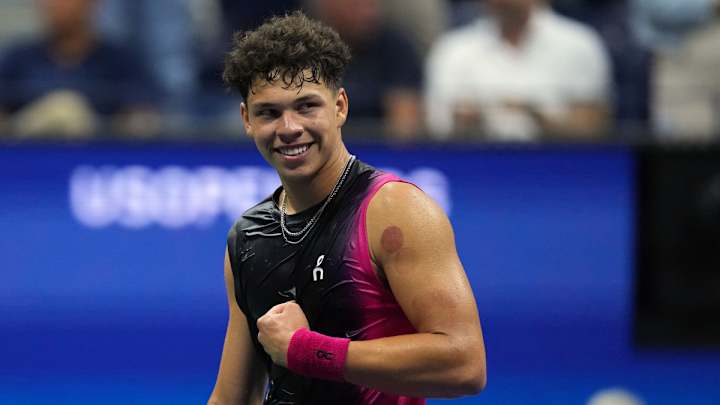SI:AM | Two Young Americans Roll Into U.S. Open Semis

Good morning, I’m Dan Gartland. I can’t stop watching this video of Rangers pitcher Cole Ragans.
In today’s SI:AM:
✈️ What really makes the Jets a threat
🤕 A troubling injury for one of the NFL’s best
If you're reading this on SI.com, you can sign up to get this free newsletter in your inbox each weekday at SI.com/newsletters.
Their combined age is two years younger than Serena Williams
Two American players picked up impressive victories yesterday to advance to the semifinals of the U.S. Open—and neither of them is old enough to legally drink.
Coco Gauff, 19, is a player even the most casual tennis observers know. She cruised past Jelena Ostapenko in the quarters yesterday, 6–0, 6–2, to reach her second grand slam semifinal. You might not be as familiar with 20-year-old Ben Shelton, but his hard-fought win over 25-year-old American Francis Tiafoe last night—6–2, 3–6, 7–6 (7), 6–2—could be a breakout moment.
Gauff has been close to a household name since reaching the fourth round of the 2020 Australian Open as a 15-year-old. She’s had plenty of success since then, winning five singles tournaments, but is still seeking her first major title. This is just the second time she’s reached the semis at a major, following her loss to Iga Świątek at last year’s French Open. Gauff will face Karolína Muchová in the semis tomorrow with a trip to Saturday’s final on the line.
Gauff’s victory over Ostapenko was not without controversy, though. The Latvian complained after the match about it being scheduled for noon Tuesday. After her upset victory over Świątek late Sunday night, Ostapenko said she didn’t get back to her hotel until 2 a.m. and couldn’t fall asleep until 5 or 6 a.m. due to all the adrenaline. She also claimed she was told the quarterfinal match against Gauff would be played at night, only to learn that it would be the first match of the day. To make matters worse, playing in the afternoon meant Ostapenko and Gauff were subjected to brutal heat, as temperatures in the New York area soared above 90 degrees with oppressive humidity. It’s no wonder the exhausted Ostapenko wilted so easily.
Muchová defeated Sorana Cîrstea in the first match of the night session, while Shelton vs. Tiafoe was the headliner. Shelton turned pro about a year ago after winning a college national championship at Florida and is 12–20 on tour this year. At 6'4", he’s known for his powerful serve (he had 14 aces but also 11 double faults in the win over Tiafoe) but is displaying a more well-rounded game at Flushing Meadows. His best shot of the night might have been during the third-set tiebreak. Shelton was within one point of losing the set when he uncorked a rocket of a forehand winner from way behind the baseline.
“An unbelievable return from way back there,” Tiafoe said later. “Come on. That’s unheard-of stuff.”
The wins by Gauff and Shelton were the biggest moments yet in what has been a great tournament for American players. Of the 16 players in the men’s and women’s quarterfinals, five were American. Taylor Fritz lost to Novak Djokovic last night, but Madison Keys will face Markéta Vondroušová in the quarters tonight with a chance to make it three Americans in the semis. While Shelton is a serious long shot to make it to the final (he’ll have to face Djokovic on Friday), upsets around the rest of the draw have cleared an easier path for Gauff. Ostapenko’s win over the top-seeded Świątek ruled out a rematch of the 2022 French Open final between Świątek and Gauff in the quarters. Up next for Gauff is the 10th-seeded Muchová in the semis, with No. 2 seed Aryna Sabalenka still looming on the other side of the bracket in a potential final matchup.
The best of Sports Illustrated

- On the eve of the NFL season, Greg Bishop looks at how Patrick Mahomes’s dedication to basketball as a high schooler helped make him a better football player.
- Clemson’s loss to Duke was evidence of how Dabo Swinney’s program has fallen behind the rest of college football, Pat Forde writes.
- While Aaron Rodgers is garnering all the headlines, Albert Breer argues that the Jets’ defense is worth attention, too.
- The defending Super Bowl champion Chiefs are No. 1 in Conor Orr’s final preseason power rankings.
- The Orioles have the best record in the AL, thanks to a style of play that looked near extinction a few years ago but has come back into vogue due to MLB’s new rules, Tom Verducci writes.
- It’s start ’em, sit ’em decision time for fantasy football players. Here are Michael Fabiano’s breakdowns of quarterbacks, running backs, wide receivers and tight ends.
- Travis Kelce injured his knee in practice yesterday, but the news might not be as bad as initially feared.
- Spain fired women’s national team coach Jorge Vilda as the fallout from Luis Rubiales’s actions after the World Cup final continues.
The top five...
… things I saw last night:
5. Giancarlo Stanton’s 400th career home run.
4. This slick play by Orioles third baseman Gunnar Henderson.
3. Jose Altuve’s three home runs in the first three innings against the Rangers.
2. Breanna Stewart’s 40-point outburst en route to breaking the WNBA’s single-season scoring record.
1. Christopher Morel’s bat flip after a clutch homer for the Cubs. This angle is even better.
SIQ
On this day in 2000, Major League Baseball finally acquired the rights to the MLB.com domain name after it had been registered six years earlier by which business?
- The Minnesota Labor Bureau
- Major League Bowling
- Morgan, Lewis & Bockius, a law firm
- Moon Landing Believers, an organization dedicated to debunking Apollo 11 conspiracy theories
Yesterday’s SIQ: On Sept. 5, 1906, Bradbury Robinson threw the first legal forward pass in American football history while playing for which school?
- Michigan
- Saint Louis
- Harvard
- Sewanee
Answer: Saint Louis. Interestingly, the school, which played such an important role in college football history, disbanded the program after the 1949 season.
In response to a rash of football-related deaths in 1905, and thanks to pressure applied by President Theodore Roosevelt, a series of rule changes were instituted for the ’06 season, the most notable of which was the adoption of the forward pass.
The forward pass was a big risk, though. An incomplete pass resulted in a 15-yard penalty, and, if the ball hit the ground without being touched, it was an automatic turnover. Add to that the fact that the ball was much less aerodynamic in those days, and throwing a forward pass was a serious gamble.
Saint Louis coach Eddie Cochems, like many of his colleagues, was initially skeptical of the forward pass.
“The game this year is one full of trickery,” Cochems said in a 1906 edition of the Fleur de Lis, a campus magazine, according to a 2021 St. Louis Post-Dispatch article. “Instead of finer and substantial [football], we now have a game of chance.”
But Cochems also saw the potential of the new innovation, adding that he believed passing “will develop many beautiful spectacular plays before the season closes,” and began wondering how to best take advantage of the possibilities presented by it. He took his players to a Jesuit sanctuary in Lake Beulah, Wis., for two months for a training camp focused solely on the forward pass.
In the team’s season opener against Carroll College, Bradbury Robinson’s first pass attempt was incomplete, but he found Jack Schneider for a 20-yard touchdown on his second try, cementing his place in football history.
The Blue and White (as the team was nicknamed, before adopting Billikens in 1910) was one of the best teams in the country that season, going 11–0 and outscoring its opponents 407–11.
